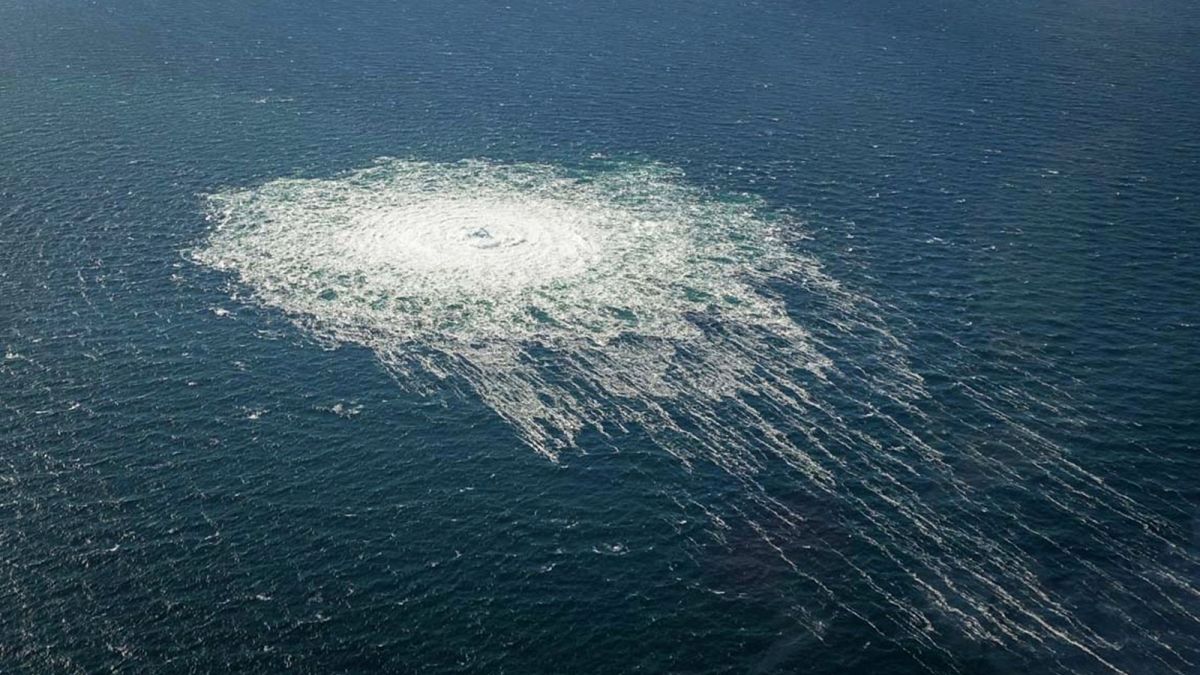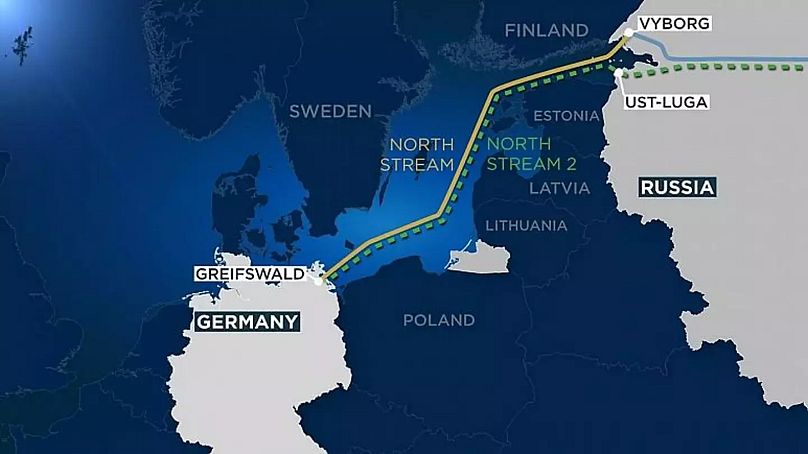Poland called it sabotage while Denmark said "deliberate actions" caused the leaks
Seismologists recorded what they think were explosions before gas began pouring out of two Russia-to-Germany pipelines under the Baltic Sea.
It's unclear what caused the blasts but they are the result of "deliberate actions", according to Denmark's prime minister, Mette Frederiksen.
Her Polish counterpart, Mateusz Morawiecki, called it "an act of sabotage".
EU Commission chief Ursula von der Leyen agreed the leaks were caused by sabotage and warned of the "strongest possible response".
Two leaks were discovered on Nord Stream 1, which Moscow shut down earlier this month in retaliation for Western sanctions over Russia's war in Ukraine.
"This is not a small crack. It's a really big hole," said the Danish Energy Agency.
Another leak was discovered on Nord Stream 2, which was frozen following Russia's invasion of Ukraine and has never been operational.
Both were in proximity to the Danish island of Bornholm.
Images and videos released by the Danish military showed a huge area of gas bubbling on the surface of the Baltic Sea. The largest disturbance has a diameter of more than one kilometre, the military said, and the smallest covers around 200 metres.
The Swedish National Seismic Network said two "probable explosions" had been recorded in the area of the gas leaks.
The first was at 2:03 on Monday, before a second one at 19:03.
'Hard to imagine it is a coincidence'
Earlier, Frederiksen did not go as far as Morawiecki, instead saying that sabotage could not be ruled out.
"It is too early to conclude yet, but it is an extraordinary situation," she said. "There are three leaks, and therefore it is hard to imagine that what is happening is a coincidence."
She was in Poland for the opening ceremony of the Baltic Pipe, a brand new route to carry Norwegian gas to Denmark and Poland.
It has been hailed as being key to slashing the EU's dependency on Russian fossil fuels.
"Today we faced an act of sabotage, we don’t know all the details of what happened, but we see clearly that it’s an act of sabotage, related to the next step of escalation of the situation in Ukraine," said Morawiecki, speaking alongside Frederiksen
The timing of the leaks and the unveiling ceremony have helped fuel the theory that these were deliberate attacks.
"It is clear that it is a military matter," Michael Claesson, chief of joint operations of the Swedish Armed Forces, told Swedish daily Aftonbladet.
On Wednesday, Denmark's defence minister Morten Bodskov will travel to Brussels to meet with NATO chief Jens Stoltenberg to discuss the gas leaks.
What has been the reaction?
Brussels has condemned the leaks as sabotage and warned of repercussions.
"Spoke to Frederiksen [Danish Prime Minister] on the sabotage action Nordstream," EU Commission chief Ursula von der Leyen said on Twitter.
"Any deliberate disruption of active European energy infrastructure is unacceptable and will lead to the strongest possible response."
The EU said in an earlier statement yesterday that the gas leaks hadn't affected the bloc's security of supply "as of yet".
In Russia, Kremlin spokesman Dmitry Peskov called the news "very concerning" and said no option should be "ruled out right now", including sabotage.
"This is an issue related to the energy security of the entire continent," Peskov said.
The United States raised the spectre of a targeted attack but was careful not to make conclusions.
"There are initial reports indicating that this may be the result of an attack or some kind of sabotage, but these are initial reports and we haven't confirmed that yet," US Secretary of State Antony Blinken said at a press conference. "But if it is confirmed, that's clearly in no one's interest."
'Unprecedented damage'
Neither Nord Stream 1 nor Nord Stream 2 are currently carrying gas flows to Europe, although a certain level of supplies remains inside the infrastructure.
The cause behind the leaks was not immediately clear but the damage appeared to be considerable.
"The damage that occurred in one day simultaneously at three lines of off-shore pipelines of the Nord Stream system is unprecedented," said Nord Stream AG, the consortium responsible for the pipelines. "It is impossible to estimate the timeframe for the recovery of the gas transport infrastructure so far."
The first leak, through Nord Stream 2, was detected on Monday evening in the pipeline's Danish section of the Baltic Sea, around the island of Bornholm, after a "major pressure drop."
The Danish Maritime Authority released a navigational warning and established a prohibition zone within five nautical miles (around 9 km) from the site, considering the leak could pose a danger to naval traffic.
Leaked gas can entail safety and health consequences for travellers and ignite above water and in the air, causing explosions. Ships may lose buoyancy, the Danish authorities noted.
The German government reached out to Denmark to examine the issue.
Hours later, two leaks were identified on different sections of Nord Stream 1: one in the Danish economic zone and another one in the Swedish economic zone of the Baltic Sea.
"Breakage of gas pipelines is extremely rare, and therefore we see reason to raise the preparedness level as a result of the incidents we have seen over the past 24 hours," said Kristoffer Bötzauw, director of the Danish Energy Agency.
The agency put the country's energy sector on "orange" alert, the second highest level, and urged companies to ensure security around their facilities.
Sweden also issued a navigation warning, asking vessels to keep a "safe distance" from the five nautical mile radius.
The Swedish Maritime Administration also sent a warning for aircraft, introducing a safety altitude of 1,000 metres above the concerned areas.
Germany has equally taken precautionary measures.
"We still have no clarity about the causes and the exact facts," a spokesperson for Germany's federal ministry of economic affairs and climate action told Euronews. "A no-fly zone has been established around the area for security reasons – the area is closed to shipping."
At 1,200 km in length, Nord Stream 1 has the capacity to carry up to 170 million cubic metres of gas per day (or 55 billion cubic metres per year). Russia has been accused of manipulating supplies after being hit with six rafts of EU sanctions in the aftermath of the Ukraine war. Flows reached 20% of maximum capacity in the summer before the pipeline was shut down.
Nord Stream 2, which was built in parallel to the original conduit, was supposed to double its total capacity to an annual 110 billion cubic metres, but the project, which drew harsh criticism from Poland, the Baltic states and Ukraine, never received authorisation.
"Today's sabotage of Nord Stream is a stark reminder of our energy infrastructure's exposure to risks," said Simone Tagliapietra, an energy fellow at the Bruegel think tank.
"[The leaks] might well be Russia's way of seeking force majeure and avoiding paying multi-billion damages to its former customers."
This article has been updated to include new reactions and developments.

